How the Boss MT-2 Metal Zone conquered the world and inspired a new generation of metal guitar players
We celebrate 30 years of the million-selling distortion pedal with an in-depth look at its history, legacy and controversy
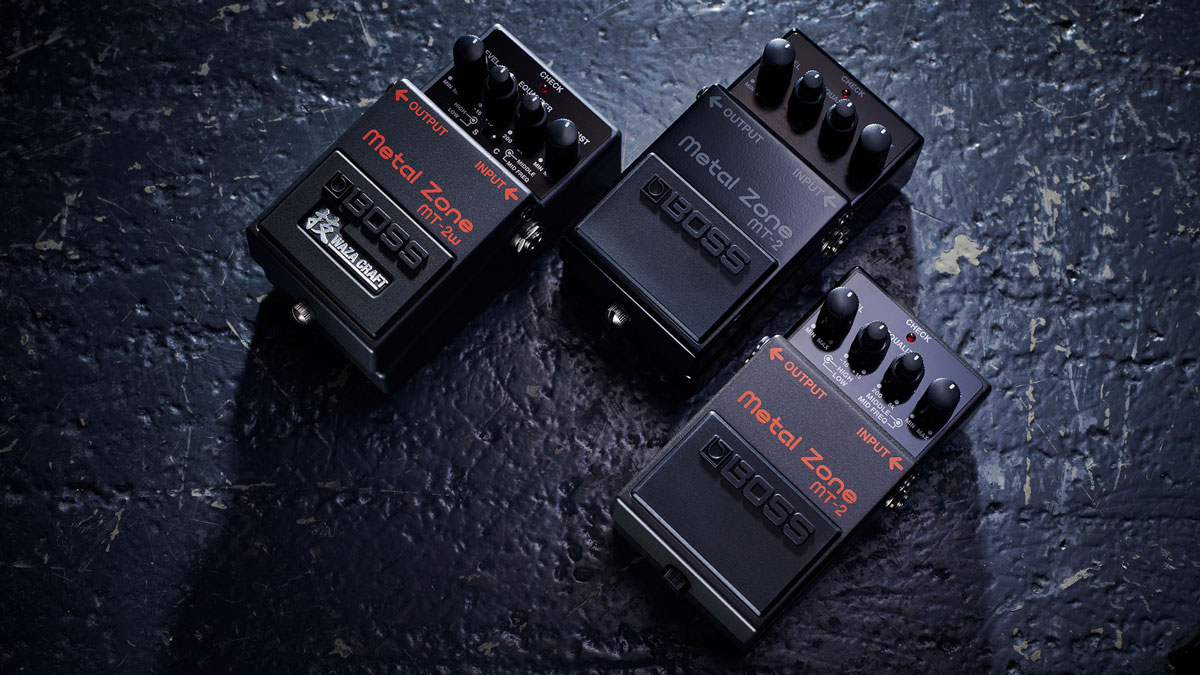
Boss has always been one for giving its effects pedals utilitarian names to explain quite explicitly what is contained within, but every now and then a little accidental enclosure poetry gets through.
It did so in 1991 with the launch of the MT-2 Metal Zone, a distortion pedal that arrived at a pivotal moment for heavy metal guitar, when a febrile underground was heating up the arms race for more gain and ever more hostile guitar tones.
What guitarist weaned on the precision chug of Hetfield and Hammett, mind-blown by the new death metal sounds coming out of Florida and Sweden, would not want to enter the Metal Zone?
The Metal Zone could quite accurately describe the headspace for this black t-shirted demographic – Disney World for heshers – and here it was, in orange text on black, in one of those compact little Boss stompboxes that somehow, with pedal culture yet to explode, seemed to be everywhere.
Boss’s reach saw to that. Every trade show would have a Boss stand, a catalog to take home, and maybe a new pedal, too. The local guitar store had them all. There is a business science story to be written about the success of the Metal Zone, which on its 30th anniversary has sold over one million units – a feat celebrated with the launch of the limited MT-2-3A, which is only available in 2021 and comes in a none-more-metal grey-on-black colorway.
It might speak about the raw power of first-mover advantage in the market for guitar effects, distribution, and marketing and so forth. Yet could be a story about Boss itself, or Fender, Marshall, or any other gear manufacturer to have enjoyed its position as market leader over the decades.
The story behind the Metal Zone’s success is better told through the sounds it was designed to produce, the unintended consequences of taking a revolutionary approach to midrange and EQ, and the culture that was assembling all around it.
Get The Pick Newsletter
All the latest guitar news, interviews, lessons, reviews, deals and more, direct to your inbox!
The rise of extreme metal and the search for extreme sounds
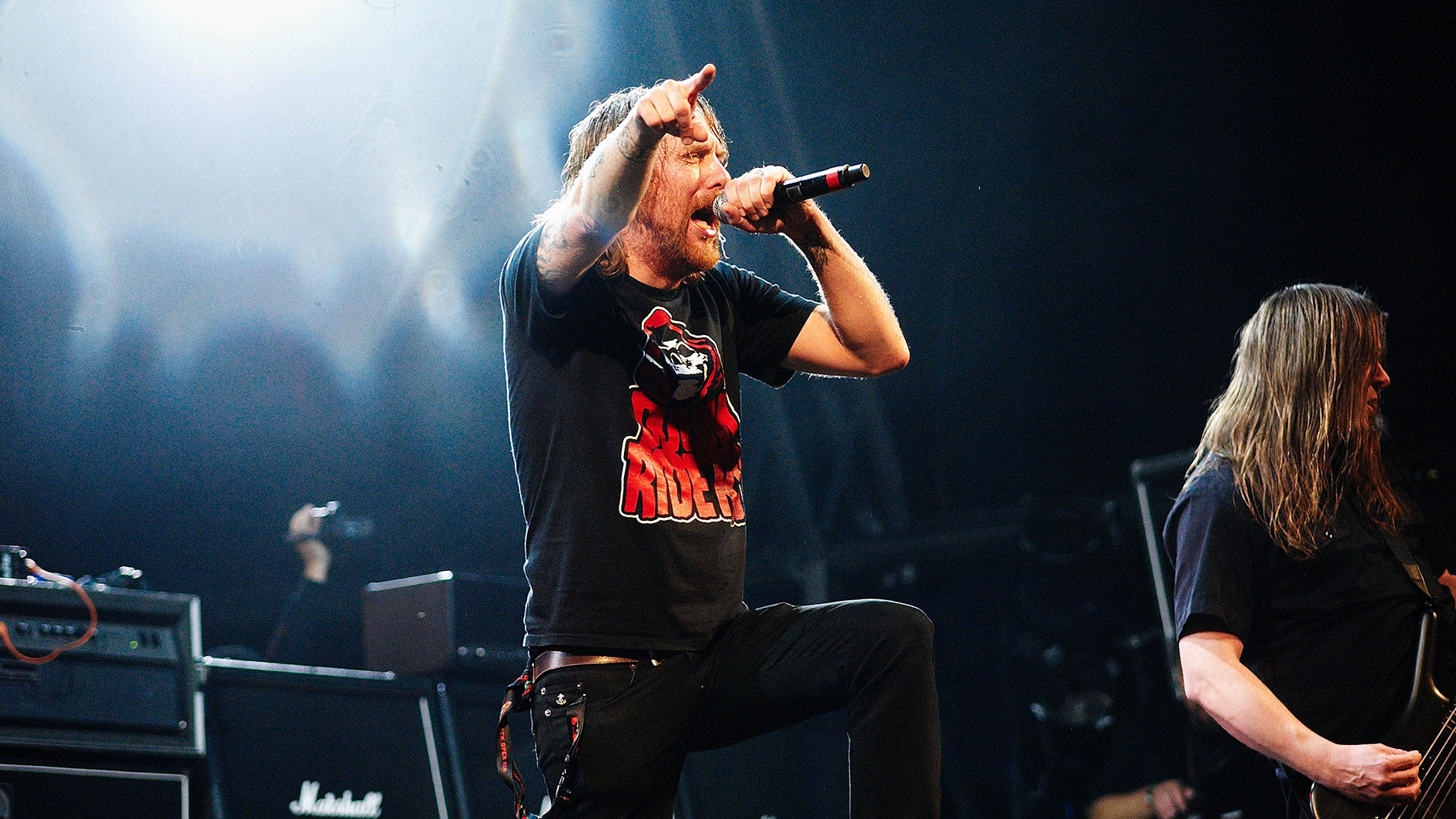
By the dawn of the ‘90s, the options for high-gain guitar amps were limited, especially for the grassroots players, and yet demand for more extreme guitar tones were needed to take the art form further was spiking. Those looking to follow in the footsteps of Carcass, Morbid Angel, Entombed, Napalm Death, Obituary et al needed something extra. Enter Boss…
“From the ‘80s to early ‘90s, high-gain guitar sounds were getting more popular and influential. Most musicians used distinctive high-gain sounds such as mid-scooped or boosted distortion,” recalls Yoshi Ikegami, president of Boss. “Unlike now, there were not many amps that could provide high-gain distortion sounds easily, so it was difficult for most non-professional guitarists to make these sounds.”
Gain supply shortages have been the story of rock ’n’ roll since the dawn of the mass-marketed electric guitar. Back in the day, a pencil through the speaker cone or a faulty mixing desk channel had to supply the dirt. With rock hardening to metal, manufacturers such as Boss looked to pick up the slack.
The key magic was focusing and boosting midrange in the first gain stage to enhance the sweet spot for guitar sound
Yoshi Ikegami, president of Boss
As early as 1978, Boss added the iconic DS-1 Distortion to its compact series. In 1983, it launched the HM-2 Heavy Metal. David Gilmour used one for a while, but the HM-2 was not a triumph in the traditional sense, and certainly not a triumph at the first time of asking.
The dead spots on the HM-2’s gain control seemed to make it an unorthodox proposition, and when it was discontinued in 1991, it was still a niche item, popularized in death metal circles by Entombed, whose debut album, Left Hand Path, established the Sunlight Studios sound, giving the Stockholm wing of Swedeath a particularly savage quality – all frequencies in red, all of the time.
If the HM-2’s sweet spot was to be found by turning everything all the way up, the Metal Zone required a little finessing. As distortion pedals go, its circuit has a lot going on.
“The MT-2 has a dual-stage gain circuit to get a decent amount of distortion,” says Ikegami. “But if this circuit [is] only boosting the gain, it will make the distortion sound from an amp muddy and not smooth.
“The key magic was focusing and boosting midrange in the first gain stage to enhance the sweet spot for guitar sound. Then the MT-2 can provide singing sustain with any amp and [at any] volume.
“In addition, there are seven filters on the circuit for pre- and post-distortion to ensure that the tone is tight and well-designed. Then by utilizing the post EQ, the MT-2 allows for shaping the tone deeply and variably for its signature sound.”
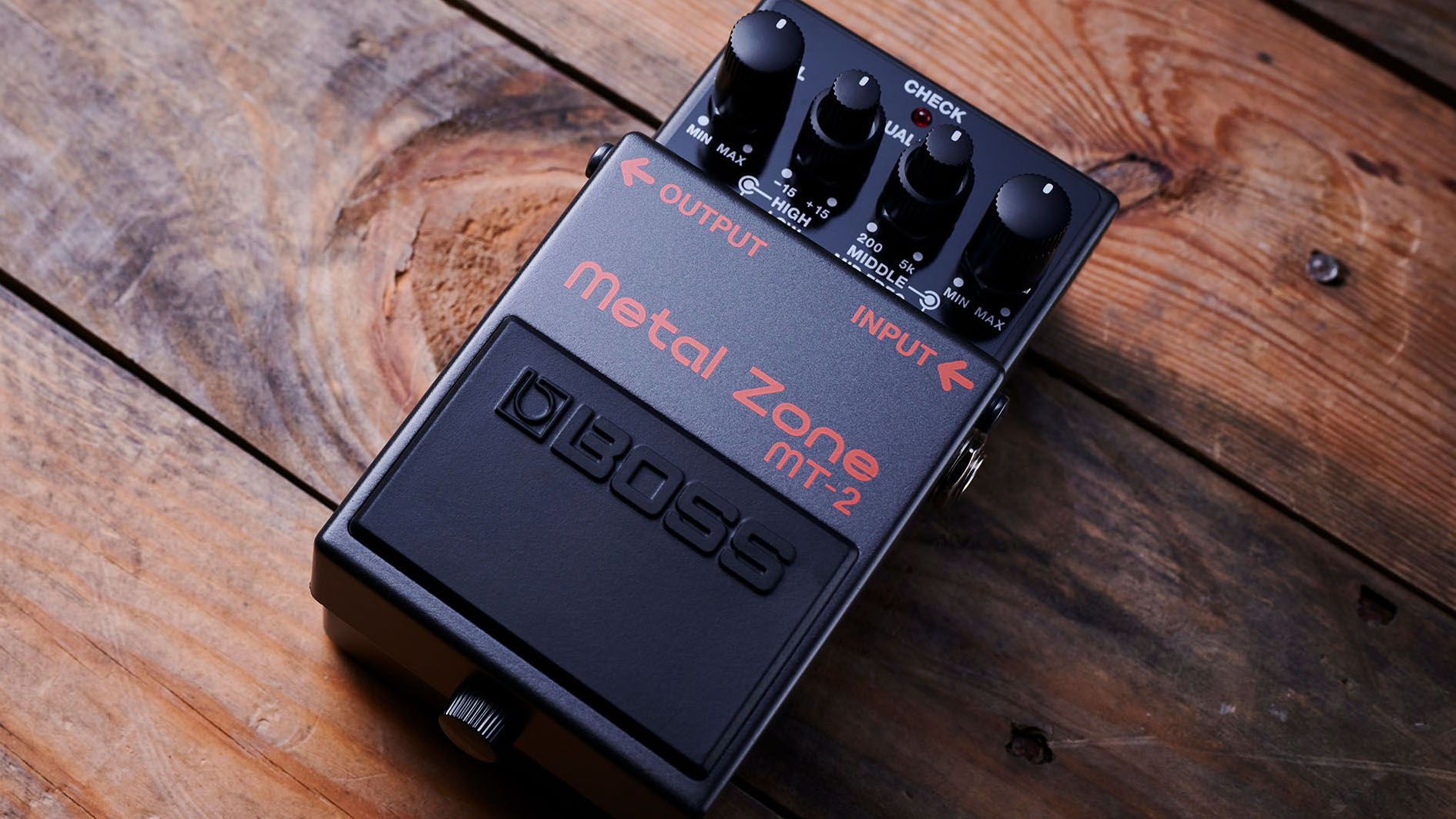
That begs the question: what is the MT-2’s signature sound? There’s certainly the sound it was designed for, but how players used it in the years to come suggested that this is a pedal of multitudes, a pedal for finding your signature sound.
That said, it was brought into this world for high-gain tones, its semi-parametric three-band EQ allowing you to set the mids anywhere between 200 Hz and 5 kHz and then apply up to +15 dB boost or cut. Dialing down the mids can work gangbusters for high-gain metal tones – particularly if you were the only guitar player in the band.
If you had a big enough amp, it’d put some muscle on those riffs; if going through an eight-inch practice amp speaker it’d at least make those harmonics bounce off the fingerboard and give you something searing to work with. For many players, certainly in the early '90s, the preference was to cut. Today’s Metal Zone users, particularly its professional fraternity, use it quite differently.
The Metal Zone’s most famous contribution to death metal came on At The Gates’ seminal 1995 album, Slaughter of the Soul, when the signal was fed through an HM-2 then into the MT-2 to tighten up the sound. Yet the more creative we get with the Metal Zone, the more uses can we can find for it.
I tried every distortion pedal on the market and every time I heard the sound that excited me, it was the Metal Zone!
Simon Neil, Biffy Clyro
“Many guitarists may think the MT-2 Metal Zone creates only heavy and aggressive sound that match to metal music due to its name,” says Ikegami.
“However, the MT-2 covers a quite wide range of tones, from crunchy overdrive to deep, high-gain sounds. Interestingly, I heard there are many jazz or blues guitarists who use the MT-2 as a preamp and EQ pedal to get silky and cut-through tone. They boost midrange with low gain, then cut high and low range to [add] focus to its midrange.”
Converge guitarist and producer Kurt Ballou would see the logic behind such a move. He has historically used the Metal Zone as a boost, rolling back the gain, keeping the EQ flat and juicing the volume to make it hit the front end of his tube amp harder.
“Even then it’s far from transparent,” he explained to Boss. “There’s some pre-emphasis EQ that’s always present which adds clarity and harmonics even at low gain.”
Nowadays, it’s more likely Ballou will use it for some studio magic, running it straight into a tube mic preamp for “blackened four-track tones”. Korn guitarist James 'Munky' Shaffer uses it similarly, dialing in lo-fi tones like those of the intro to Did My Time.
One of the most high-profile Metal Zone users doesn’t even play metal, and yet for Simon Neil of Scottish rock band Biffy Clyro, the pedal is an integral part of his sound. Of all the distortion pedals in the world, after all these years, his heart is still with the Metal Zone.
“I tried every distortion pedal on the market and every time I heard the sound that excited me, it was the Metal Zone!” he told Total Guitar last year. “I swear, even at this stage in my life, the Metal Zone speaks to me in a way that no other pedal does, because of the saturation. The thing that makes it sound a little bit cheaper than other pedals is what excites me so much. It has this chaos in the high frequencies. You can really make your guitar shriek!
“It’s such a big part of my tone, combining it with a really on-the-nose, crisp and slightly overdriven tone. That is my sound. I haven’t been able to find a pedal that can do the same thing, even Big Muffs.”

Not everyone enjoys the Metal Zone’s over-the-edge quality. The Metal Zone divided opinion upon its launch. It divides opinion now. Just Google “Boss MT-2 Metal Zone” and the first suggested link that comes up under ‘People also asked’ reads, “Is the Boss Metal Zone that bad?” But its flexible EQ and gnarliness when provoked are what attract players such as Neil.
That Metal Zone offers so much control over its EQ presents players with options, and that can either be inspiring or confusing. A little patience is needed. Often it is a case of using the Metal Zone with another drive to bring out the sound you need.
That’s what Neil does. He couldn’t do without it, though he cautions that those controls require a steady hand to dial in the sound you need. “I’ve got it within half a millimeter of my exact settings – if one of the knobs gets knocked even slightly, that’s my whole sound gone to shit,” he says. “It came from years of dialing in and getting closer and closer. My sound really comes alive with that pedal. Even after trying to move on and evolve, it’s still top of my list!”
The Metal Zone is almost always a key ingredient to the mix. The reason we’ve used it so often in the studio is because it just sounds so evil. And it’s very flexible
Nathan Weaver, Wolves in the Throne Room
Nathan Weaver of Wolves in the Throne Room says the key to unlocking the Metal Zone’s potential is in blending it with different amps. WITTR’s sound is built on layers and layers of differently textured tones. There’s no one amp/pedal combination that unlocks it. But if you audit their discography and the gear used, you’ll definitely find the Metal Zone a near ever-present. Weaver is definitely among its super-fans. In his opinion, there’s no pedal with an EQ as powerful or flexible.
“The Metal Zone is almost always a key ingredient to the mix,” says Weaver. “The reason we’ve used the Metal Zone so often in the studio is because it just sounds so evil. And it’s very flexible. One might call the Metal Zone sound ‘cheap’, but I’d describe its brutal, necro sound as ‘perfect.’ For me, its sound evokes Barrow-wights in a graveyard, and dusty old bones in an ancient crypt.
“It is definitely more of a fucked-up, corpse-grinding type sound. Not a pleasant, warm boutique tube amp tone at all. WITTR does a lot of tremolo picking with intertwined harmonies, and for us the Metal Zone is perfect for a lot of applications because the sound is so precise and defined.”
Used judiciously, the Metal Zone can tighten up your amp’s sound. Some amplifiers just need a little guidance, a physical presence to tighten them up and make them seaworthy. The Metal Zone does that. This was how Weaver found the rhythm guitar tone on Two Hunters – an album that should be required study for anyone interested in extreme metal guitar.
Back then, Weaver was running an old Marshall JMP through a Marshall 4x12 loaded with Celestion Greenbacks, and a '70s Sunn Model T through a similarly vintage cab. He then combined those amps – “that sounded like an explosion” – with a Metal Zone going through a Marshall JCM800 head. “The sleekness and sharpness of the Metal Zone made the wall of fuzz from the vintage amps sound tight and brutal,” he says.
For lead guitar tones, Weaver typically switches things up. But once again, on WITTR’s new album, Primordial Arcana, the Metal Zone is right there, going into a Fender Princeton and an Orange Rockerverb. “Both layers were also going through an old Roland Space Echo,” explains Weaver. “I think those lead sounds are some of my favorites we’ve done. They glisten and have a crystalline sound to them.”
The Metal Zone’s legacy
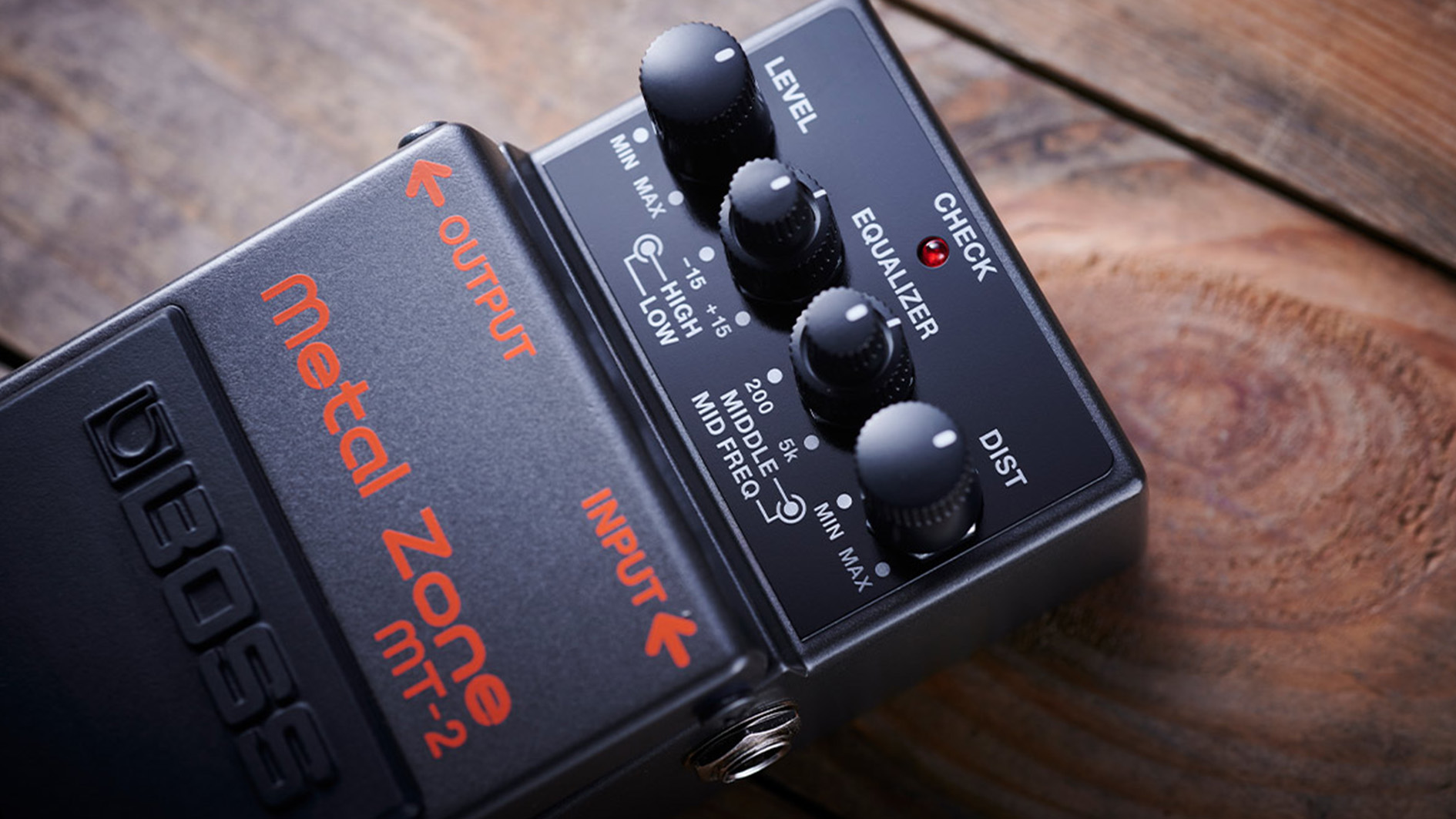
The Metal Zone might not be a cultural totem for the underground in the same way that the HM-2 Heavy Metal became. ‘HM-2 bands’ became a colloquialism for any extreme metal bands mining the old Sunlight Studio sounds for old-school death metal revivalism or for injecting some venom into d-beat, hardcore and grindcore sounds.
Such was the HM-2’s cultural cachet, Finnish grind band Rotten Sound put one on a t-shirt. The HM-2 did for metal what the Big Muff did for alt-rock and grunge. But there’s an argument that says the Metal Zone has been the more important pedal; it’s just that, often, we don’t see its impact.
Many of those who have built their sound on it – the Simon Neils and Nathan Weavers and the jazz and blues cats – have used it in so many different ways. It was clever marketing to call the pedal the Metal Zone, but perhaps that sold the pedal short.
Even at the highest gain settings, the low end remains full yet tight, focused, and well-defined, perfect for chugging out low-tuned riffs
Yoshi Ikegami
The Metal Zone has been used on Prince’s The Undertaker. Many believe that this is what Guy-Manuel de Homem-Christo and Thomas Bangalter used on Daft Punk’s debut to make their Juno synth sound like it does on Rollin' and Scratchin’.
Search the internet, and you’ll find pages dedicated to modding it – Brian Wampler will even show you how to turn it into a Tube Screamer if that’s your kind of thing. It even got caught up in the Covid-19 disinformation discourse when an elaborate online hoax shared its schematic and maintained that it was really a 5G chip to be administered to patients via the vaccine.
Under appreciated, misunderstood, whatever; 30 years on, the MT-2 Metal Zone remains in production and is an evergreen pedalboard choice. In 2018, Boss released a Waza Craft version of the Metal Zone, with an enhanced Standard mode joined by a Custom mode voiced for contemporary metal styles.
“Even at the highest gain settings, the low end remains full yet tight, focused, and well-defined, perfect for chugging out low-tuned riffs,” says Ikegami of the MT-2W’s Custom mode. “The sound also cleans up very nicely when reducing your guitar’s volume, putting an extremely balanced range of tones under your fingers.”
But perhaps the Metal Zone’s greatest cultural impact can be observed in the generations of guitar players it has weaned on high-gain. For many metal players, the MT-2 was a rite of passage, a crucial staging post en route to finding the sound they’d take on the road.
When all is said and done, getting young players the sound they need to inspire them at the most crucial stage in their development as musicians is the very definition of a cultural impact.
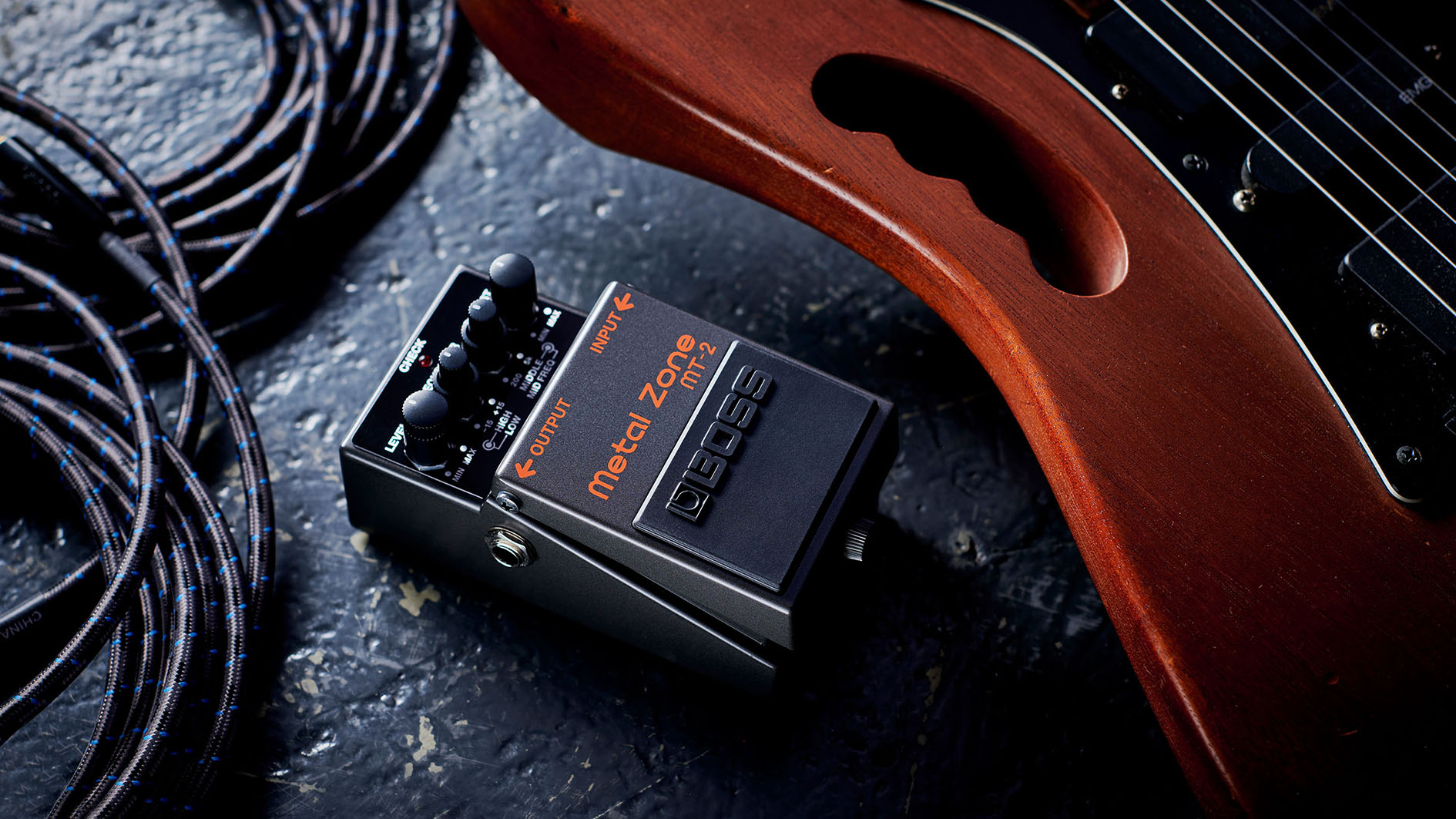
When Mark Holcomb of Periphery was reunited with a Metal Zone for a video segment in 2017, he had long decommissioned his, but he spoke of how it helped him to envision himself playing guitar in a heavy metal band.
“It was my favorite pedal and I haven’t played one in years,” he said. “I mean, it does sound pretty brutal. It kills pinch harmonics.
“If I didn’t have it when I was a teenager, it would have been a lot harder for me to stand there in my room, miming along to Metallica sounds, daydreaming about playing a stadium or something like that. Because that is what I would do. I would play the whole Master of Puppets record on a Metal Zone. Standing up, I think I had a Epiphone Les Paul when I was young, down to my knees, playing it like Hetfield would play it.”
Max Bowman of Olympia, Washington death metal band Mortiferum was another. He might have graduated to going straight through a dimed Orange amp to find the appropriate texture of gain for Mortiferum’s über-doomy riffs, but the Metal Zone helped open the gates to that world.
“I used a Boss Metal Zone when I was growing up, when I first got into death metal,” says Bowman. “The earliest death metal I got into was Death and Obituary, and also the stuff that was popular around people my age was stuff like Nile and Decapitated. But Cannibal Corpse, specifically, I remember talking to a friend of mine and I was like, ‘I got to get that tone, man. How do I get that crazy tone?’ And he was like, ‘Try a Boss Metal Zone.’
“I asked my dad, ‘Hey I really want this pedal. My birthday’s coming up.’ And he got me one! I had a hard time getting the sound I wanted out of it, but I had a lot of fun with it, and I still think it is a cool pedal. I think they’re sick, and fucking cool and old-school. That EQ was the reason I didn’t stick with it. I was too young to really understand how tone works. Maybe if I tried one now I’d have a different experience.”
Worst distortion pedal ever? Go home, internet. You’re drunk. It’s like Weaver says, “Hail the Metal Zone!”
Jonathan Horsley has been writing about guitars since 2005, playing them since 1990, and regularly contributes to publications including Guitar World, MusicRadar and Total Guitar. He uses Jazz III nylon picks, 10s during the week, 9s at the weekend, and shamefully still struggles with rhythm figure one of Van Halen’s Panama.












